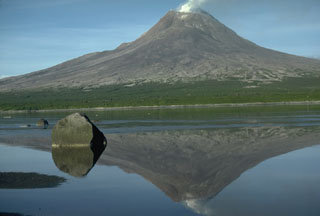Report on Augustine (United States) — May 1986
Scientific Event Alert Network Bulletin, vol. 11, no. 5 (May 1986)
Managing Editor: Lindsay McClelland.
Augustine (United States) Activity subsides after dome extrusion
Please cite this report as:
Global Volcanism Program, 1986. Report on Augustine (United States) (McClelland, L., ed.). Scientific Event Alert Network Bulletin, 11:5. Smithsonian Institution. https://doi.org/10.5479/si.GVP.SEAN198605-313010
Augustine
United States
59.3626°N, 153.435°W; summit elev. 1218 m
All times are local (unless otherwise noted)
Following the extrusion of its new dome between [23] and 28 April, activity at Augustine decreased rapidly. As of 7 June, a variable steam plume carrying small amounts of ash was still being emitted from the summit, occasionally to 3 km altitude. Scientists on the island 6 and 7 June noted an intense sulfur odor in the plume and a strong halogen smell on the pyroclastic flows. They measured a temperature of 400°C at a depth of 30 cm in a pyroclastic flow on the volcano's N flank. As of 11 June, tens of individual earthquakes were being recorded daily by the seismometer on the N flank of the volcano, indicating brittle fracturing of the cooling dome.
Geological Summary. Augustine volcano, rising above Kamishak Bay in the southern Cook Inlet about 290 km SW of Anchorage, is the most active volcano of the eastern Aleutian arc. It consists of a complex of overlapping summit lava domes surrounded by an apron of volcaniclastic debris that descends to the sea on all sides. Few lava flows are exposed; the flanks consist mainly of debris-avalanche and pyroclastic-flow deposits formed by repeated collapse and regrowth of the summit. The latest episode of edifice collapse occurred during Augustine's large 1883 eruption; subsequent dome growth has restored the edifice to a height comparable to that prior to 1883. The oldest dated volcanic rocks on Augustine are more than 40,000 years old. At least 11 large debris avalanches have reached the sea during the past 1,800-2,000 years, and five major pumiceous tephras have been erupted during this interval. Recorded eruptions have typically consisted of explosive activity with emplacement of pumiceous pyroclastic-flow deposits followed by lava dome extrusion with associated block-and-ash flows.
Information Contacts: J. Kienle, Geophysical Institute, University of Alaska, Fairbanks; M.E. Yount, Branch of Alaskan Geology, USGS Anchorage.

